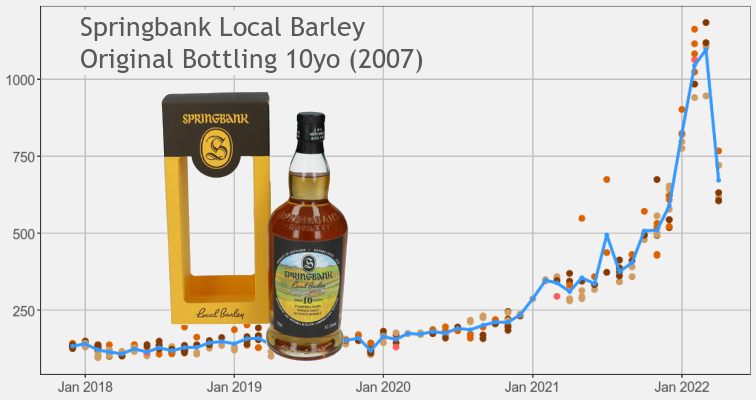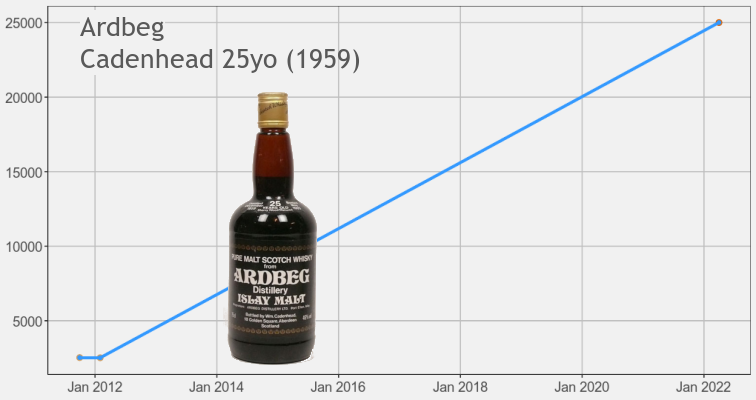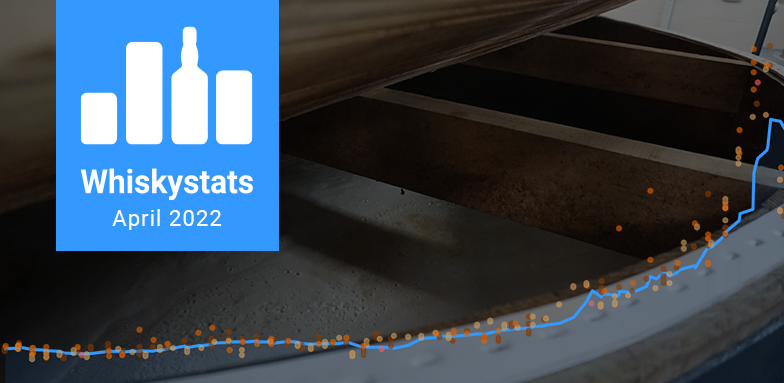We observed a significant setback for many Springbanks where the Local Barleys stood out. Meanwhile, some old Yamazaki releases and an Ardbeg from 1959 have just returned to auctions. Here is the Whiskystats Price Update for April 2022.
The April round of auctions brought more than 18 thousand new price observations to our database. Like last month, our primary market index, the Whiskystats Whisky Index (WWI), did not move significantly. The 500 whiskies included gained a mere 0,5% in value, and hence the WWI remains at its peak at around 360 index points. Islay whiskies gained 3%, while the most traded Speyside whiskies lost 3%. Campbeltown stands out with a minus of -8,3%, and Springbank is again responsible for that.
Springbank Breather
The vast value gains for Springbank were the loudest topic on the secondary market over the past couple of months. From November 2021 to March 2022, our Springbank index exploded from 248 to 358 index points, equalling a 45% gain. But apparently, the laws of physics also apply to Springbank, and what goes up comes down eventually. The historically 100 most traded Springbanks lost over 7% in value in this latest round of auctions. As is often the case, the once biggest value gainers now experienced the most significant setbacks. The prime example is the Local Barley range with the Springbank Local Barley 10yo (2007) displayed below.

This Campbeltown single malt sold on average for 510 Euros in the November round of auctions. In the following months, single lots went as high as 1.180 Euros. However, prices in this latest round fell as low as 605 Euros. This setback equals a 50% loss within a couple of weeks. But there are even more extreme examples. The Local Barley 11yo (2006) peaked at 1.449 Euros and dropped to 661 Euros. And the Local Barley 16yo (1999) fell from over 3.000 Euros to less than 1.600 Euros occasionally. There are plenty more examples, and not just Local Barleys. Many of them have in common that prices fell back to their level from the end of last year.
Yamazaki Returnees
While our distillery index indicates a relatively quiet month for Yamazaki (+0,22%), some Yamazaki releases on offer haven’t been available on auctions for a long time. A couple of them found their way into the ten highest value-gaining whiskies this month. Topping that list is the Yamazaki Sherry Cask 2011. Until now, this Japanese rarity sold only three times on the auction houses we track. The last price point came in February 2015 at 805 Euros. At Whisky Auctioneer (WAE), a bid was made at 8.159 Euros this month, which equals a 914% value increase over seven years.

We want to highlight the second Yamazaki returnee, the Yamazaki Single Cask cu70065. This 15-year-old, distilled in 1998, now fetched over 13.000 Euros. Compared to the 1.600 Euros from 2016, this equals a 700% increase. Even more expensive is the Yamazaki Single Cask du65300. After this whisky disappeared from auctions for five years, it is selling for 14.500 Euros. Last but not least is the Yamazaki Single Cask 2v70480. Also not seen for five years, the up-to-date price level is now at 5.700 Euros.
Remarkable Trades
There is another long-gone whisky which celebrated its auction comeback this month. Cadenhead’s Ardbeg 25yo (1959) Sherry Wood recorded only two trades in late 2011 and 2012. On both occasions, the hammer fell at 2.500 Euros. Ten years later, the price is tenfold as 25.000 Euros was the final bid last week.

It not often happens that an Ichiro’s Malt Card loses value two months in a row. But this is what we have now observed for the Hanyu Eight of Spades. One of the once existing 629 bottles sold for 17.200 Euros in February. Then, in March, the price tag dropped to 15.800 Euros. And now it gave way again as 13.800 Euros were enough to claim the highest bid.
The secondary whisky market is on a constant move. Stay on top of the market by becoming a Whiskystats member.
Disclaimer: the whisky market insights presented in this article are based on the Whiskystats database at the time of publication. Whiskystats is constantly adding new data, and therefore some charts and figures may not match after initial publication.
